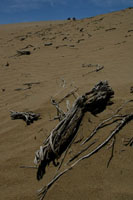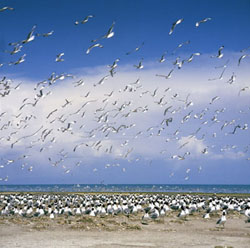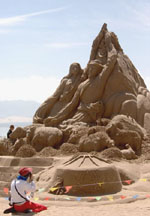Expert urges preservation of Qinghai Lake
By Du Wenjuan (chinadaily.com.cn)Updated: 2007-07-11 15:12 For over ten thousand tourists at the first Qinghai Lake Sand Sculpture Festival, sand on the banks of Qinghai Lake in Haiyan, Northwest China's Qinghai Province are just another tourist attraction, showing off the beauty of the lakeside area.
|
|
Meanwhile, the lake currently covers an area of 4,200 square kilometers, but in the 1950s, it was over 4,500 square kilometers.
Experts points out if Qinghai Lake continues to shrink at the current speed, its current average depth of 18 meters will disappear within two centuries.
Darkness over the beautiful pool
Located at an altitude of over 3.6 kilometers on the Qinghai-Tibet Plateau, Qinghai Lake is the largest inland sea and salt-water lake in the country. It also used to be both a huge natural mirror reflecting the beautiful landscape of western China and was a natural shield sheltering the vast east area of the lake from turning into desert.
As a national natural reserve, Qinghai Lake was listed as one of the Wetlands of International Importance in 1992. But due to global warming and human activity, this natural ecosystem is under threat. Over 1.87 million mu (about 1,250 square kilometers) of land have become desert so far, the third largest desert area in this province.
According to the Qinghai Tourism Bureau, the Qinghai-Tibet Railway will bring 400,000 new visitors to Qinghai Lake every year. And statistics show, the population around the lake has grown to 90,000 from 20,000 in the 1950s, due to farming around the lake area.
 Visitors ride on camels in the lake area, July 10 2007. Camels have become a source of income for local farmers these years, though they only appear in deserts. [newsphoto]  |
There are 213 kinds of wildlife living around the lake area, including 37
under first and second protection like snow leopards, Tibetan wild donkeys and
black-necked cranes. But over 15 percent of the precious wildlife is facing
extinction.
 Sticks of dead wild trees are seen among the sand, July 10 2007. [newsphoto]  |
"The environmental situation around Qinghai Lake has changed drastically or even deteriorated, which is directly related to excess reclamation and overgrazing," said Yin Hong, a wetland expert from the State Forestry Administration.
Trudge along the road of rectification
Faced with the severe situation, the local government started to throw tens of millions of yuan at the problem since 2001.
 Bird Island in Qinghai Lake taken by Zhan Guoguang in May 1984.[photo.bokee.com]  |
The overall deterioration has not yet been contained, though partly improved with hard work. The government has promised to invest another 6.9 billion yuan to completely restore the fragile ecology around the lake.
Urgently appealed by some Qinghai NPC deputies early this year, a draft statute of environmental protection around Qinghai Lake was promulgated by the Qinghai provincial government and will go into force on August 1 this year.
Whether Qinghai Lake, or the 'blue sea', will return to its previous blue
water and sky is a wait-and-see concern for environmentalists and every visitor
to Qinghai Lake.
|
||
|
||
|
|

